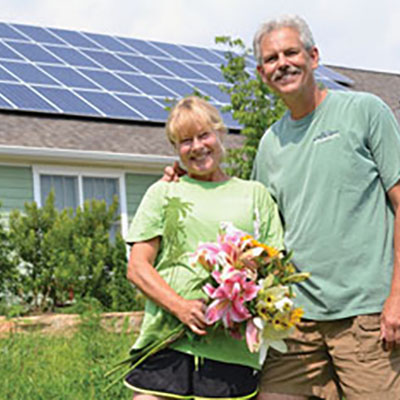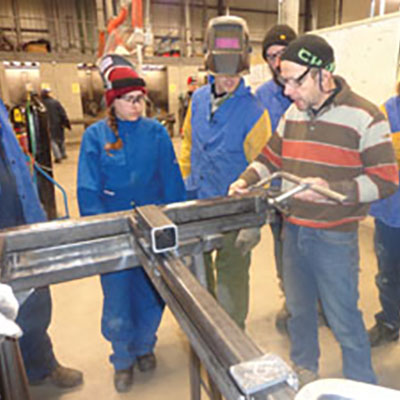For years I have been hearing the term “IMO,” though it wasn’t until this past year when I started to see an increasing number of market gardeners talking about these IMOs that I began digging in. I quickly found myself buried in a heap of acronyms, yet captivated by an exciting new approach to soil and plant health.
The term IMO, I would soon learn, stands for indigenous microorganisms. This term is used to refer to microorganisms—primarily fungi and bacteria—that the farmer has collected from his or her own farm as opposed to buying them in a bottle.
The idea of using beneficial microorganisms is nothing new, of course—activators, inoculants, teas, and so on are all widely available for purchase. In recent years, more and more commercial microbes aiming to improve soil fertility or fight disease have come onto market. Indeed, these “agricultural microbials” are estimated to become a six billion dollar industry by 2022 and major agricultural companies like Bayer and Monsanto have begun investing heavily in them.

Though there has been evidence these ready-to-go microbes can work, the results may be inconsistent and rely heavily on conditions or environment, requiring routine applications to see continued results. That said, the science is sound that healthy populations of certain microbes—beneficial fungi, bacteria, protozoa, nematodes and so on—play a profoundly important role in soil and plant health. So it is perhaps no wonder that Korean Natural Farming (or popularly, KNF), a style of farming designed around the encouragement of those microbes, would be receiving a great deal of interest and enthusiasm.
For an innovative compost making method using forced air instead of turning, read the article "Static aerated compost pile heats right up without turning."
What is Korean Natural Farming?
At least partially in response to increasing dependence on synthetic chemicals in South Korea in the 1960s, Dr. Cho Han Kyu sought to design a way for local farmers to generate all or most of a farm’s own fertility needs out of waste products from the farm itself—egg shells, compost, wild plants, etc.
Dr. Cho thus combined plant biology with a Korean penchant for fermentation and, through much testing, developed what is now referred to as Korean Natural Farming.
To get a better understanding of the concepts behind KNF, I contacted Chris Trump. As one of the lead practitioners and promoters of KNF in the United States, it is Chris’ YouTube videos that may serve as one of your first navigators through the intricacies of making the various KNF preparations and understanding the practice if you desire to learn more. He also does KNF consultations and sells various tools and materials through his website, naturalfarming.co. When I put the question of “What is KNF?” to Chris, he described it simply as a “nicely packaged” and “elegant” way of tending the soil.
Chris went on to explain that there are really two sides to the KNF coin. The first side is the collection of inoculum. These would be your IMOs—the bacteria and fungi indigenous to one’s own environment, collected through specific methods (described below) that are adapted to your local area. The “microbial seed for your land,” offers Chris.

The author took this wooden box, filled it with cooked rice, covered it with a paper towel and used mycelium from the forest to inoculate it with IMOs.
Chris says that “bugs in a jug”—as he affectionately refers to the bottled agricultural microbials—can be effective. However, “they often have a fall off. You need more of them. They are not increasing year-after-year. They need to be re-upped. You buy another bottle, and have the same effect for the next crop or the next six months. And the idea with indigenous microbes is that if done well, you have a sampling of nature and it’s from your local environment. So after you apply it, it persists and likes your barometric pressure, your rainfall, and the specific types of microbes. You don’t have the same fall off every year. They’re waking back up [in the spring] and you’re benefiting from that self-perpetuation that occurs naturally in a forest.”
The second side of the KNF coin is timing, using these preparations when the plant needs them. “The right nutrients at the right time,” as a KNF practitioner might say.
In his book “Cho’s Global Natural Farming,” (available to read for free online at tinyurl.com/ydbpfnd7) KNF’s founder Dr. Cho pays special attention to timing, called the Nutritive Cycle Theory, that “plants and livestock need different nutrients during different stages of growth.” These nutrients then are all derived from various preparations that can be made relatively cheaply and found locally.

What KNF looks like in practice
Collecting IMOs is central to Korean Natural Farming. KNF is not a practice like, say biodynamics, where you are able to purchase all the requisite preparations and simply add them to your land in lieu of making your own. That would defeat the purpose of KNF. The objective lies in that word indigenous—you want microbes that already thrive in your microclimate. This requires, however, a bit of process.
Though not intended as a recipe, any article about KNF would be remiss to not describe how IMO is collected. So here is a quick rundown for this staple of Korean Natural Farming:
Streamed rice is placed in a wooden box (cedar or bamboo is recommended) with small holes in the bottom. The box is covered with a paper towel (stapled on). Then that box is set inside some sort of cage to keep rodents out. That is your basic set-up. Now, all of that is taken out to a nearby forest, preferably with old growth woods, and placed somewhere with a visually abundant population of fungi, located by gently searching below the leaf mold for the telltale white mycelium. A small collection of sticks and leaves with mycelium attached are laid gently over top of the paper towel—a handful will do.
This rice box is then covered with a tarp and left for 3 to 7 days depending on the temperature (less time in warmer periods), or until mycelium and other microbial populations have colonized the rice in the form of white hyphae spreading through it.
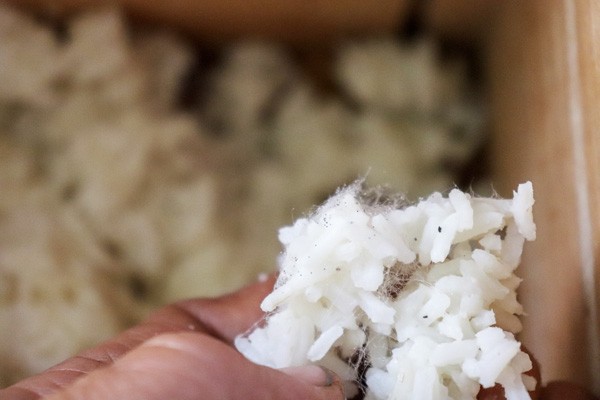
This is what the author's rice looked like once it was inoculated with IMOs. They fungal hyphae are visible as white fuzz.
This is what KNF practitioners call IMO-1 (the first stage of IMO). The rice and “mold” is then weighed and mixed together with brown sugar. This sugar stabilizes the microbes, essentially sending them into an arrested state (called IMO-2) where they can easily be woken back up again. Then it is mixed with rice bran or some other carbonaceous material in low piles and lightly composted to enliven the indigenous microorganisms (which makes IMO-3). That mixture is then added to soil and composted at low temperatures again (IMO-4), which itself can be diluted and sprayed on fields or added to a compost pile or woodchips to be composted a third time (making the final IMO-5).
Throughout this process, practitioners will add other KNF preparations like fermented plant juice (FPJ), or Oriental Herbal Nutrient (OHN). Seawater may be employed at different times as well.
For more on soil health, read the article "What we learned from participating in the Pasa Soil Health Benchmark Study," from the April 2021 issue of Growing for Market Magazine.
All of these preparations have multiple uses, and KNF deals with more than just soil. There is a whole side to the practice that deals directly with the plants. As stated above, adding the right nutrient at the right time is a critical part of KNF. For instance, Cho recommends a water soluble calcium (abbreviated WS-CA, made from toasted egg shells and vinegar) at several different stages including “the cross-over period when the growth of crop changes from vegetative to reproductive growth.” Most all of the preparations have a multitude of applications and are shelf-stable for months if not years of utility. So even if a little money is needed for brown sugar or rice, that investment theoretically pays back for many years to come.
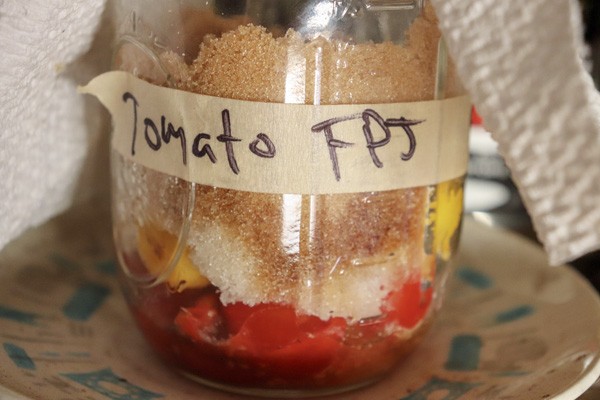
Adapting KNF techniques to your farm
The same obstacles that inspired KNF to come into existence persist even in the natural farming world—a reliance on outside resources for the things plants need. “We all know plants need calcium,” writes Alex Ekins of Ace of Spades Farm outside of Spokane, WA, in an email, “but the only answer was to buy it. Now I can make apple cider vinegar out of my apples. I can save my eggshells from my chickens and by combining the crushed and roasted shells with the vinegar you can create water-soluble calcium that can, with other inputs, be foliar applied to fruiting plants. KNF in my mind gives you a natural approach to creating your own fertility free from the salesmen and fertilizer companies. And as a farmer I need to always be looking to reduce my bottom line while improving my soil and plant health.”
I was inspired to dive into this practice. Immediately I was met with a familiar hang-up that growers face when first breaking into the literature: many KNF preparations were derived in a tropical environment and the recipes often involve ingredients not found here in Kentucky, such as banana flowers for the Fermented Plant Juice or licorice for the OHN preparations, to name a few.

However, many practitioners including Chris Trump are working to identify the best local plants in their area to supplement. Bryan O’Hara of Tobacco Road Farm suggested some smart, straightforward swaps like using oat bran in place of rice bran for the IMO-3, because most of the US does not have rice bran in the abundance they do in Korea. That came simply by trial and error for Bryan—the oat bran could be found locally and worked well for promoting fungal growth.
For the plant-based recipes, however, Bryan suggests “we take our clues from herbal medicine and use plants that grow locally” when adapting one of Dr. Cho’s recipes to his area in Connecticut. So for him that is nettle, plantain and comfrey, as well as beets, carrots, purslane and rutabaga. He ferments these according to the KNF guidelines and uses all of the resulting preparations differently based on their anti-fungal or anti-bacterial or immune enhancing properties.
This works, posits Bryan, as plant and animal immune systems use these herbs similarly. In other words, he suggests the reaction that a certain herb has in a human is similar to the reaction it will have in a plant or animal. “An antioxidant is still an antioxidant,” an anti-fungal is an anti-fungal, and so on. When we consume a plant for immune enhancing properties, he says, plants can use that herb in much the same way. So when he is choosing plants with which to replace those that Dr. Cho originally identified for KNF, he doesn’t order in the tropical plants from Cho’s recipes necessarily, but rather Bryan looks to herbal medicine and then around his own farm for equivalent substitutions with the properties he needs.
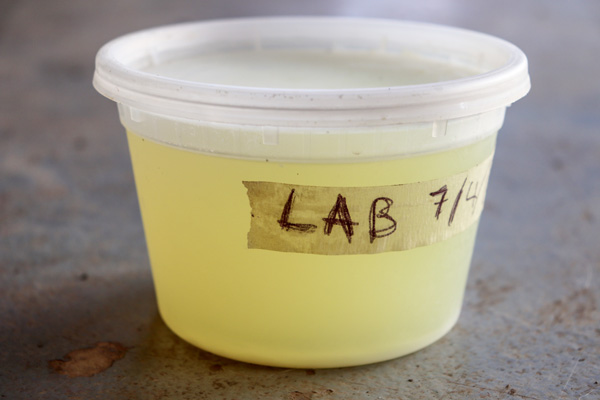
The author's lactic acid bacteria.
Closing the loop
In some ways—though it has been around since the 1960s—KNF is still in its infancy in a global sense. KNF is well established in Korea, but relatively new to North America. However, farmers like Bryan and Chris and Alex as well as many others are figuring it out. They are adapting Cho’s work to their own climates, and doing so because KNF offers farmers who have always wanted to generate their own fertility and “close the loop” the opportunity to do so. It is attractive to be able to have the ideal of a closed loop system in a way that isn’t idealistic—that employs science and experience and materials we all have access to. There is creativity involved and satisfaction to it, as Alex from Ace of Spades describes it.
Resources
Cho’s Global Natural Farming
tinyurl.com/ydbpfnd7
Natural Farming Hawaii
naturalfarminghawaii.net
Natural Farming Company
naturalfarming.co
Use of KNF for Vegetable Crop Production in Hawaii
tinyurl.com/yatfkq43
For more on Korean Natural farming and growing healthy soil, check out The Living Soil Handbook by Jesse Frost.
Subscribers always get 20% off all books from GFM.
Jesse Frost is a no-till market gardener and freelance journalist from Kentucky, and is the host of The No-Till Market Garden Podcast. You can find him at roughdraftfarmstead.com or on YouTube under Rough Draft Farmstead.

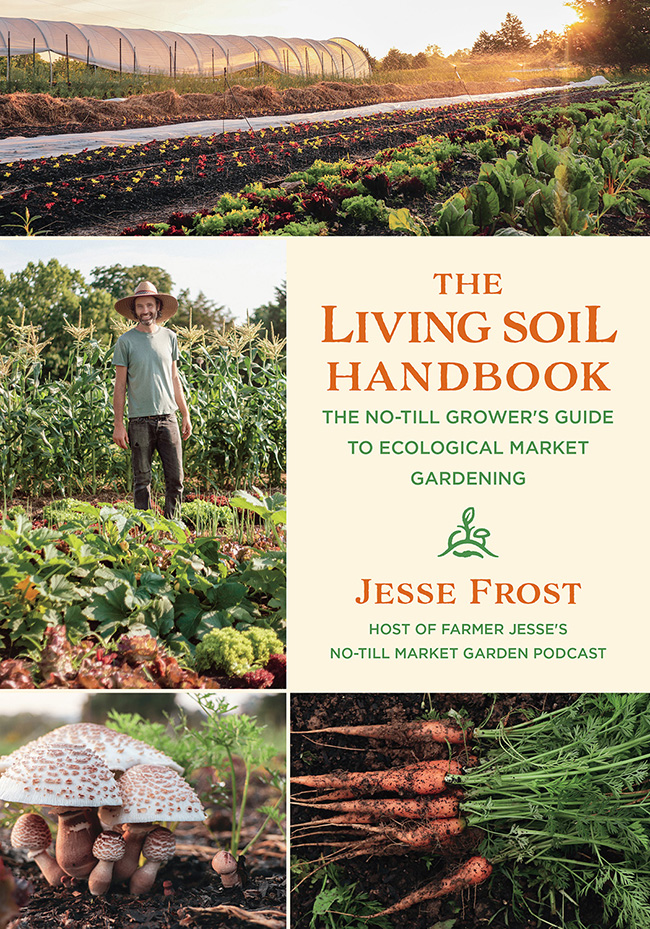

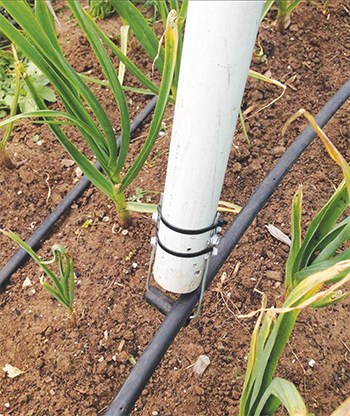 When I saw this tool I knew the exact need that inspired its creation and I loved seeing the abundant comments from other farmers around the world who had also created their own versions, born of that same common need. Nat Wiseman from Village Greens of Willunga Creek near Adelaide in southern Australia posted a very simple and relatively quick fix to the problem of laying drip lines in garlic after the canopy has already filled in.
When I saw this tool I knew the exact need that inspired its creation and I loved seeing the abundant comments from other farmers around the world who had also created their own versions, born of that same common need. Nat Wiseman from Village Greens of Willunga Creek near Adelaide in southern Australia posted a very simple and relatively quick fix to the problem of laying drip lines in garlic after the canopy has already filled in.

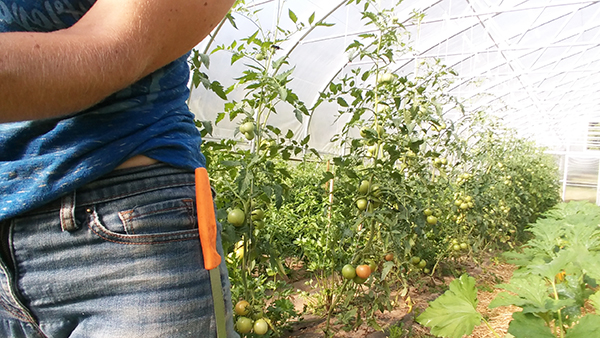 Another simple and relatively inexpensive tool drew me in on social media this month – a magnet in the place of a knife sheath submitted by Kat Johnson, the Produce Manager at Fields Edge Farm in Floyd, Virginia.
Another simple and relatively inexpensive tool drew me in on social media this month – a magnet in the place of a knife sheath submitted by Kat Johnson, the Produce Manager at Fields Edge Farm in Floyd, Virginia.
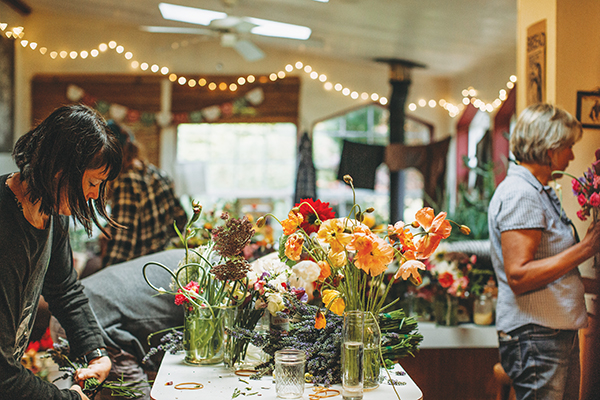 Weddings are a huge opportunity for local flower farmers, especially with the growing awareness of and demand for seasonal, sustainable flowers. And, if there is one time that people really want special flowers, it’s at their weddings.
Weddings are a huge opportunity for local flower farmers, especially with the growing awareness of and demand for seasonal, sustainable flowers. And, if there is one time that people really want special flowers, it’s at their weddings.
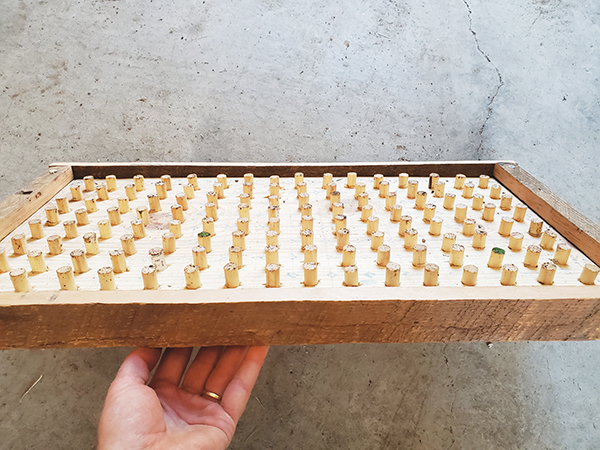 Megan French from Boundless Farmstead near Bend, Oregon, posted these dibblers she built on Instagram and reminded me that I need to get my act together. On their farm they’re typically seeding 30 to 100 trays per week with a vacuum seeder. To get evenly dibbled holes before making the dibbler boards they were using a single bolt with a nut and washer to set the depth. One. Cell. At. A. Time. Which understandably was slow.
Megan French from Boundless Farmstead near Bend, Oregon, posted these dibblers she built on Instagram and reminded me that I need to get my act together. On their farm they’re typically seeding 30 to 100 trays per week with a vacuum seeder. To get evenly dibbled holes before making the dibbler boards they were using a single bolt with a nut and washer to set the depth. One. Cell. At. A. Time. Which understandably was slow.
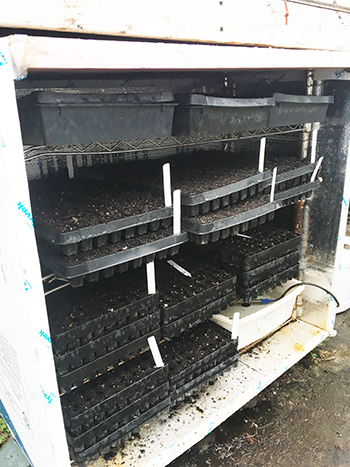 Until two years ago I was germinating all seedlings in greenhouses using almost exclusively bottom heat from electric heat mats. At my current farm we only had space for about 8-10 trays on our two mats and we definitely noticed differences in the germination (and presumably the heat the mats were providing) on the edges of our trays.
Until two years ago I was germinating all seedlings in greenhouses using almost exclusively bottom heat from electric heat mats. At my current farm we only had space for about 8-10 trays on our two mats and we definitely noticed differences in the germination (and presumably the heat the mats were providing) on the edges of our trays.